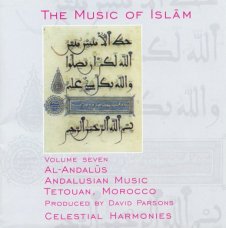 |
|||||||||||||||||||||||||||

The Music of Islam Sampler (13159).
In seiner aufwendigen Forschungsarbeit folgt David Parsons den vielfältigen
Spuren der heutigen islamischen Musik zurück bis zu den Wurzeln.
Das Ergebnis ist eine Produktion, die international Aufsehen erregte
und 1998 den Preis der Deutschen Schallplattenkritik erhielt: Auf
insgesamt 17 CDs spielen und singen Gnawas und Derwische, Muezzins
und Volksmusiker. Von Indonesien und Pakistan bis Tunesien und Südspanien
reicht das geografische Spektrum, über 12 Jahrhunderte das historische.
Zu jeder CD gibt es ein sehr informatives, etwa 50-seitiges Begleitheft
(in englisch). Man kann die CDs einzeln oder als Gesamtpaket in einer
Holzbox erwerben. Hier die Zusammenfassung der ganzen Serie. Ausgezeichneter
Einstieg.
the projectTen years in the making, The Music of Islam series recorded in Egypt, Morocco, Tunisia, Turkey, Yemen, Pakistan, Indonesia, Iran and Qatar represents the most comprehensive sound documentation available to Westerners today, of a world religion dating back to 1/622. Although governed by strict rules for fourteen centuries, contact with other cultures has radically affected Islamic music throughout history. As the world enters the XV/21st century the timing of this collection serves an even larger purpose, documenting the traditions that have survived and will continue to survive for centuries to come. Today, one fifth of the world's population, one billion people, are Muslims, occupying a large territory stretching from the Atlantic shore of north and west Africa, through west, central, and south Asia to island southeast Asia, and attracting an increasing following in India, western Europe, north America, east Asia, and southern Africa. This is a global presence which cannot be ignored. North Africa became the stronghold of Arab–Andalusian music after the fall of Granada in 897/1492, yet the existence of the nubah (plural nubat, literally rotation or succession) system in Morocco can be traced back earlier, to at least the XI/12th century. Much of the repertoire has been lost over the years, and different areas preserve different nubat. In Morocco today, there are at least two distinct styles of Arab-Andalusian music, al-Ala, which is the most prevalent one across the country, and Gharnati, specific to Oujda in eastern Morocco and to Tlemcen in Algeria. These traditions are considered to be Morocco's classical musical heritage. The repertoire of the al-Ala today is highlighted in this volume. It consists of eleven nubat which were standardized in the late XII/18th century. A nubah is divided into five sections, each corresponding to a particular mizan—rhythmic pattern. Within each of these rhythmic phases, there is a slow and a fast version of each mizan. A nubah is actually never performed in its entirety, for this could take over six hours. Each Moroccan nubah contains between 95 and 153 songs and instrumental pieces. The layout of the nubah functions more as a matrix of possible performance choices than as a plan that must be adhered to. A typical nubah performance will consist of several pieces from a few different rhythmic phases. the artistsMorocco, home to some of the richest Islamic music,
became the recording site of three volumes in The Music of Islam
series: Volume 5: 'Aissaoua Sufi Ceremony (14144),
Volume Six: Gnawa Music (13146) and
this volume. Recorded at the Palace Bouhlal, deep in the Medina—old
city—of Tetouan, which is, with Fes, one of the two centers of
al-Ala music in Morocco, shows the living tradition that
is the musical heritage of al-Andalus.
The musicians of the featured ensemble are ambassadors of this living tradition. Led by El Kacimi Mohamed, the ensemble uses traditional Arabic instruments. El Kacimi Mohamed plays the kamanja (violin), Ahmed El Kamas plays the 'ud (lute), Abdelkarim Doukhou plays the nay (flute), and percussionists Abdelilah Azlas and Mohamed El Rhouni play the darabukka (clay goblet drum) and tar (tambourine). tracklist
|
|||||||||||||||||||||||||||
|
|
|||||||||||||||||||||||||||
 |


